
(a)
Interpretation:
The ketone or aldehyde that can be used to produce the given compound when treated with
Concept introduction:
Answer to Problem 21.61P
The ketone that can be used to produce the given compound when treated with
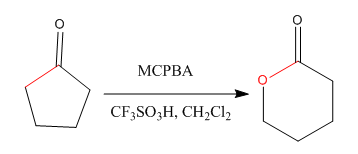
Explanation of Solution
The given compound is:
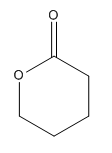
The given compound is an ester that can be produced when a ketone treated with the
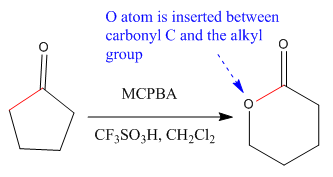
The ketone that can be used to produce the given compound is drawn, removing the oxygen next to the carbonyl C which is inserted when it reacts with
(b)
Interpretation:
The ketone or aldehyde that can be used to produce the given compound when treated with
Concept introduction:
Answer to Problem 21.61P
The aldehyde that can be used to produce the given compound when treated with

Explanation of Solution
The given compound is:

The given compound is an acid that can be produced when a aldehyde is treated with

The ketone that can be used to produce the given compound is drawn, removing the oxygen next to the carbonyl C which is inserted when it reacts with
(c)
Interpretation:
The ketone or aldehyde that can be used to produce the given compound when treated with
Concept introduction:
Answer to Problem 21.61P
The ketone that can be used to produce the given compound when it is treated with

Explanation of Solution
The given compound is:

The given compound is an ester that can be produced when a ketone is treated with

The ketone that can be used to produce the given compound is drawn, removing the oxygen next to the carbonyl C which inserted when it react with
(d)
Interpretation:
The ketone or aldehyde that can be used to produce the given compound when treated with
Concept introduction:
Answer to Problem 21.61P
The ketone that can be used to produce the given compound when it is treated with

Explanation of Solution
The given compound is:
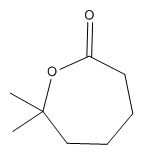
The given compound is an ester that can be produced when a ketone is treated with
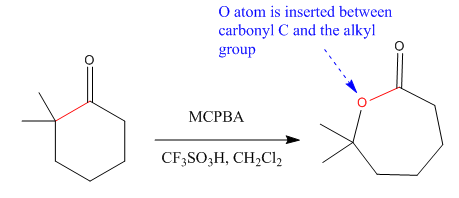
The ketone that can be used to produce the given compound is drawn, removing the oxygen next to the carbonyl C which is inserted when it reacts with
Want to see more full solutions like this?
Chapter 21 Solutions
ORG.CHEM W/TEXT+SOLU.MANUAL
 ChemistryChemistryISBN:9781305957404Author:Steven S. Zumdahl, Susan A. Zumdahl, Donald J. DeCostePublisher:Cengage Learning
ChemistryChemistryISBN:9781305957404Author:Steven S. Zumdahl, Susan A. Zumdahl, Donald J. DeCostePublisher:Cengage Learning ChemistryChemistryISBN:9781259911156Author:Raymond Chang Dr., Jason Overby ProfessorPublisher:McGraw-Hill Education
ChemistryChemistryISBN:9781259911156Author:Raymond Chang Dr., Jason Overby ProfessorPublisher:McGraw-Hill Education Principles of Instrumental AnalysisChemistryISBN:9781305577213Author:Douglas A. Skoog, F. James Holler, Stanley R. CrouchPublisher:Cengage Learning
Principles of Instrumental AnalysisChemistryISBN:9781305577213Author:Douglas A. Skoog, F. James Holler, Stanley R. CrouchPublisher:Cengage Learning Organic ChemistryChemistryISBN:9780078021558Author:Janice Gorzynski Smith Dr.Publisher:McGraw-Hill Education
Organic ChemistryChemistryISBN:9780078021558Author:Janice Gorzynski Smith Dr.Publisher:McGraw-Hill Education Chemistry: Principles and ReactionsChemistryISBN:9781305079373Author:William L. Masterton, Cecile N. HurleyPublisher:Cengage Learning
Chemistry: Principles and ReactionsChemistryISBN:9781305079373Author:William L. Masterton, Cecile N. HurleyPublisher:Cengage Learning Elementary Principles of Chemical Processes, Bind...ChemistryISBN:9781118431221Author:Richard M. Felder, Ronald W. Rousseau, Lisa G. BullardPublisher:WILEY
Elementary Principles of Chemical Processes, Bind...ChemistryISBN:9781118431221Author:Richard M. Felder, Ronald W. Rousseau, Lisa G. BullardPublisher:WILEY





